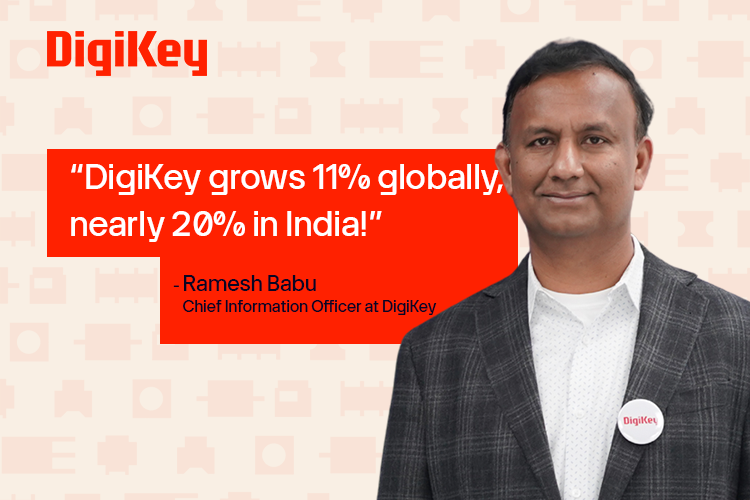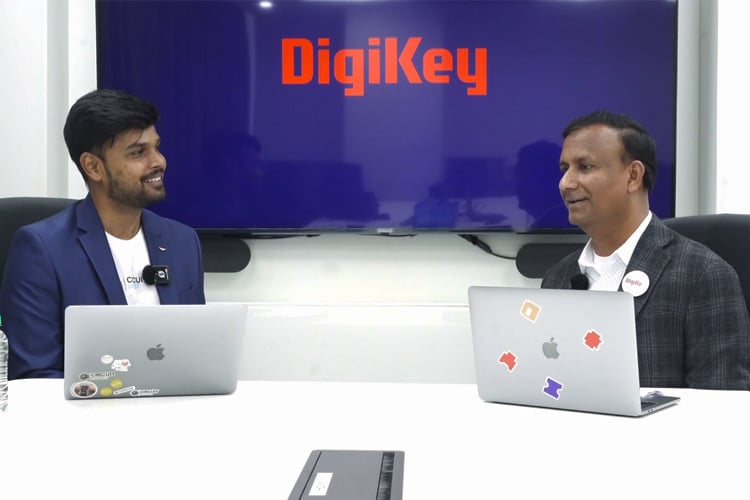
Recently, DigiKey officially launched its Indian subsidiary, named Digi-Key Electronics & Automation Trading Private Limited, incorporating its existing Global Capability Center (GCC) in Bengaluru. “We always considered this location to be a very strategic hub for DigiKey,” stressed the company’s CIO, Ramesh Babu, in an exclusive interview with CircuitDigest. He’s been with the company for over 10 years and leads the technology portfolio of the company, from architecture to infrastructure. He is also involved in executive decision-making and ensuring that the company is geared for what’s ahead. The chat covers the organization's culture, the local engineering talent, approach to AI, efforts to improve customer experience, and what the debut of the distributor’s local subsidiary represents.
“This is part of DigiKey. It is not one department of DigiKey,” is a distinction that means a lot in an industry where many global capability centers (GCC) are often nothing more than cost-arbitrage plays.
Table of Contents
A Zero-Layoff History
“We have never laid off in the 52-year history of DigiKey,” emphasized Ramesh. “So when we hire, we take time. It is sometimes frustratingly slow, but the reason is we are really making sure you are a fit.” He noted that the average tenure with the company of someone from the US spanned over 25 years, as people who join them seldom leave. The company intends to replicate that in India and is confident it has been on target in this department for the past three years. This is an approach that should resonate with candidates who are tired of being treated as nothing but disposable resources.
“We want people to own and be part of the company. So that's kind of the overall vision for us when it comes to the DigiKey India office.”
India Mathematically Matters
DigiKey.in accounts for the second-largest share of web traffic among the company’s 45 websites, behind only its US platform. Globally, the company saw 11% year-over-year growth this year, while India registered nearly 20%. According to Ramesh, the country has maintained double-digit growth even in slow cycles. The even more significant number is the million-plus engineering grads entering the workforce each year, all eager to make a real impact.
The numbers above go way beyond abstract statistics. They’re proof of how India is a critical growth engine for DigiKey. Strong traffic and faster-than-global growth signal a highly engaged market. The steady stream of engineering talent translates to a pool of skilled professionals and also a constant demand for components, tools, and solutions. All of this put together highlights an ecosystem that’s ready for innovation, where both companies and engineers can create real value.
Ramesh believes his position allows him to understand both Western and Indian markets in depth. To him, the area where India’s engineering talent stands out is its sense of ownership. Unlike teams that simply support a project, he sees the professionals here wanting to lead initiatives, make decisions, and take responsibility. This mindset, he notes, fosters stronger commitment and drives better results.
Going Local, Fully
Using a crawl-walk-run approach, the company tested the waters with the GCC setup first and did not rush into creating this legal entity. “I am happy we didn't jump headfirst right away,” expressed Ramesh. “Sometimes the mistakes big companies do is, decisions get made from a remote place based on a few PowerPoint slides. So we wanted to be present here, and that allows us to understand it even better from a customer perspective. What is the market growth, whether it is the AI, whether it is the EVs, like, you get the first-hand knowledge by having your boots on the ground.”

Overcoming bureaucratic red tape, DigiKey now plans to understand the market and local landscape better. The company has already started actively engaging with universities, engineering forums, and conferences. Over everything, being truly local brings the company closer to the community's pulse and ensures feedback reaches their radar more effectively.
A piece of feedback that regularly surfaced at DigiKey concerns customs clearance, which tainted an otherwise positive purchasing experience. To tackle this, the company partnered with an Indian logistics provider that takes care of customs and last-mile delivery, addressing a primary source of customer frustration. This example portrays how proximity bridges the gap between customer feedback and actionable solutions.
AI Across Departments
“There is not one conversation that goes without the 'AI' word coming into the picture," replied Ramesh while encountering a question on AI. “Before jumping into an AI use case, we said we need to create the infrastructure for AI. So if you look at our three years, we didn't talk the word AI. We silently invested in the data infrastructure, the API infrastructure, microservices. And now, if you look at our architecture of AI ecosystem, it can scale up and down very easily. So we are able to move large amount of data in and out of AI learning models seamlessly without having to buy anything additional."
He also reasoned why the company looks at AI as a tool, as opposed to a strategy, and acknowledged the hype that surrounded the term. Over the course of this year, the company has deployed around 40 AI applications, with 30 more scheduled for the next three months. The focus has always been on grounded applications to meet practical needs. The company’s customer service benefits from AI integration, but its use of the tech extends well beyond that. Payment processing, which varies between the 180 countries it serves, used to slow down operations a lot. With human oversight still in place, the implementation of AI helped reduce the time it took to do this from days to a matter of seconds.
AI was even applied to less obvious areas like calculating tariffs, when that blew up. With more than 17 million SKUs in its catalog, being able to help customers sort products based on tariffs goes a long way towards making things convenient. Through the use of AI, the company also replaced traditional parametric filtering with a natural-language interface. This way, customers can just type what they need instead of having to tediously click through numerous filter options.
Where to From Here?
As DigiKey settles into its new phase as a fully local entity, the focus now is on expanding its capabilities in India. “We don’t even use the word ‘B2C’ or ‘B2B’ in our vocabulary. Even big orders get treated the same way a $1 order would go through,” Ramesh said, describing how DigiKey approaches scaling. “When you want to scale it becomes difficult. Because a $1 order, that is just one part that we need to do versus a bill of material that has 100 line items. We have created a manufacturing line type concept where all orders sequentially go through. Now we are rethinking that.”
Becoming fully local in India fits naturally into this approach. Because if we scaled out a bit, at a fundamental level, it’s about a commitment to meet customer expectations, be it an equal experience regardless of order size or something else. This is also why the distributor does not want to lose control of the software side of things to third-party vendors. Being able to build bespoke software that simplifies end-user engagement is something they’ve always valued. While the GCC made DigiKey present here, being a legal entity lets them act more independently. So what the future holds is closer collaborations, a more thoughtful experience for customers, and a wide range of other integrations into India’s electronics ecosystem.

